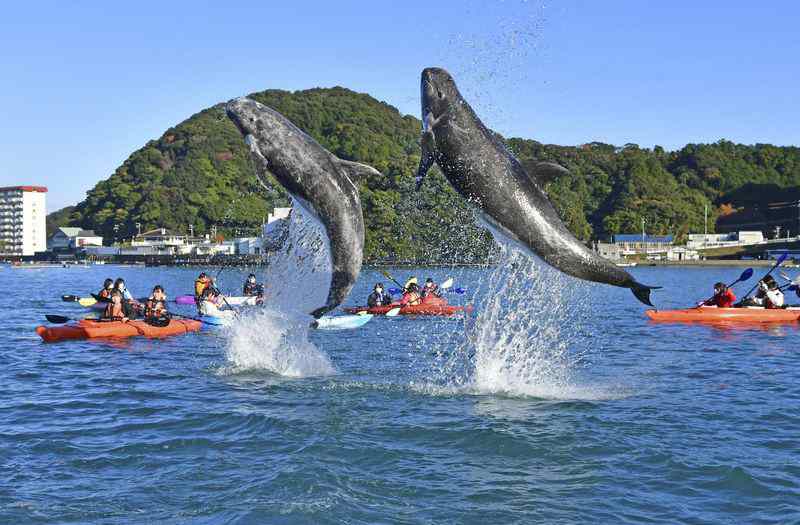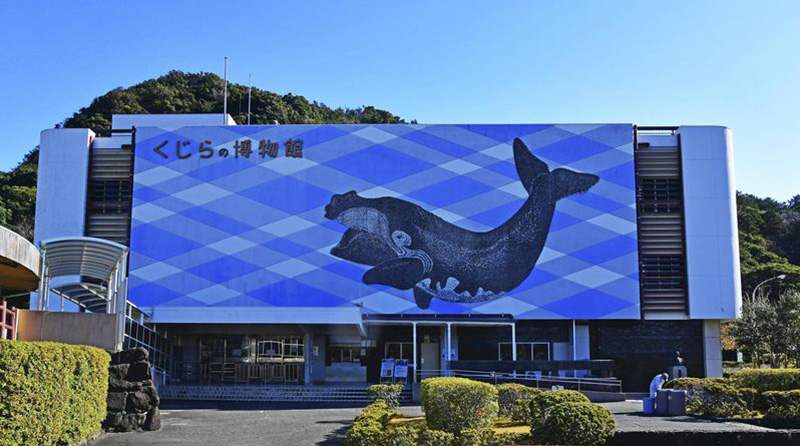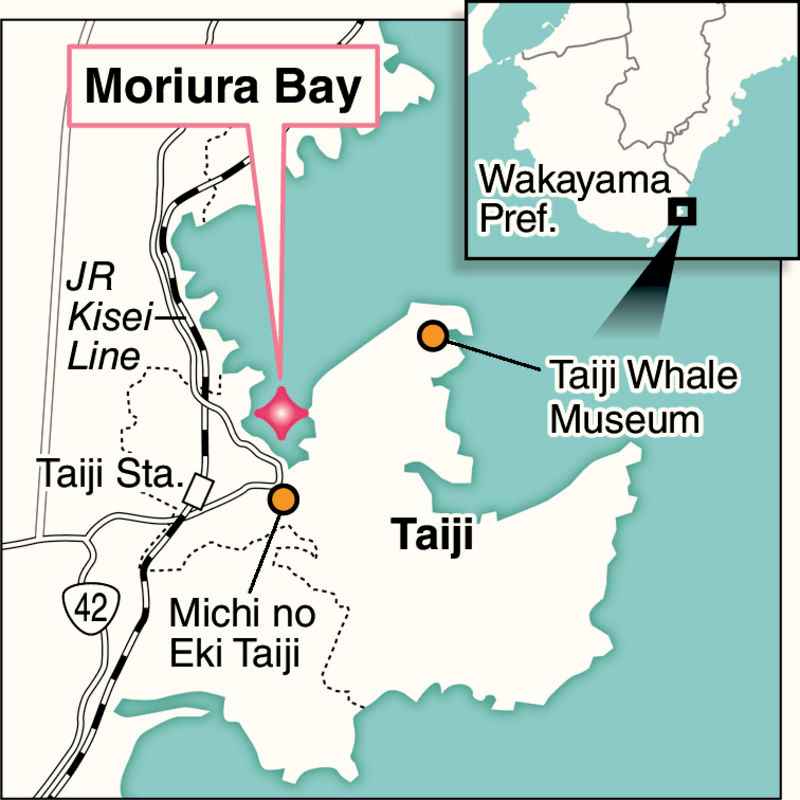
Dolphins jump out of the sea in front of high school students on kayaks in Taiji, Wakayama Prefecture.
13:07 JST, February 12, 2022
TAIJI, Wakayama — A place known as “the town of whales” in Wakayama Prefecture offers the chance for visitors to see small cetaceans such as Risso’s dolphins in a quasi-natural environment. The town is also swiftly gaining a reputation as a place for relaxation and healing.
Taiji is on the east side of the Kii Peninsula and faces the Kumano Sea, where the Kuroshio current flows from the south. Moriura Bay, surrounded by mountains on three sides, makes whale and dolphin sightings there possible.
Unique experience
About 80 high school students experienced kayaking in the bay in December of last year, floating on gentle waves. The second-year students of Toin High School in Wakayama City all wore life jackets while being accompanied by instructors. The kayaking attraction operator ensures even beginners are able to enjoy kayaking with ease.
Risso’s dolphins and blue-white dolphins swam near the students as they kayaked. The dolphins have been trained by the staff at the nearby Taiji Whale Museum, which is run by the town.
Every time the dolphins leapt out of the water, the students cried out with joy.
“I could almost touch a whale. It was a valuable experience I just can’t have anywhere else,” said Koshiro Okada, one of the students.
400-year history
As the birthplace of Japanese traditional whaling, Taiji has been engaged in whaling for more than 400 years. Coastal whaling and dolphin drive hunting still continue to be conducted in the town.
The municipality in 2006 declared it would coexist with cetaceans in the future and compiled the “Sea of the whale concept” in 2010 to create opportunities for people to be with whales in a natural environment.
An about 380-meter net was installed to separate the bay from the open sea in February 2020. The separated area of the bay is about 280,000 square meters — the equivalent to six Tokyo Domes.
More than 100 cetaceans of six species, including short-finned pilot whales and Pacific white-sided dolphins, are raised in 35 preserves. Of them, five to eight whales and dolphins are released from the preserves every day to have them swim freely in the bay.
The municipality also organizes water activities such as kayaking to give people more opportunities to have contact with such animals. It also built a 158-meter walking path over the water, from which people can see the cetaceans released in the bay, along with bottlenose dolphins from a preserve, up close.
Despite the pandemic, the kayaking office received reservations every day in October, when many schools held school trips. In a survey, all students who experienced kayaking responded positively.
“The popularity of this exceeds our expectations,” said Yoshifumi Kai, a senior official of the Taiji Fisheries Association, which operates the kayak event.
While the association currently allows up to 160 people to participate per day, he said this would increase to 200 people per day from this spring.
“We would like as many people as possible to come see the whales,” he said.
Promoting the area
The Taiji town government and other entities are trying to add more details to the “Sea of the whale concept” to help promote tourism and regional revitalization.
The roadside rest area “Michi no Eki Taiji” opened as the gateway to the bay in August 2017. The rest area sells local specialties and introduces the history and culture of the town in terms of its involvement with whales. A restaurant run by the fisheries association offers dishes using whale and tuna.
The town government said Taiji is also aiming to become an academic research city for whales. The municipality invited the Tokyo-based Institute of Cetacean Research to open a branch in the town. The facility will be built there in the near future.
“We would like to turn Taiji into a place where you can learn everything about whales,” said Mayor Kazutaka Sangen.

People walk on a path over the water.
— Extend your trip!
Taiji Whale Museum
The museum is a social education facility that tells the history of whaling and conducts research on cetaceans. A diorama shows ancient whaling as practiced from the Edo period (1603-1867) to the Meiji era (1868-1912) while it displays 1,000 items related to the biology of cetaceans and whaling, including skeletal preparations and whaling equipment.
It also holds various events like dolphin shows and provides opportunities to have contact with small cetaceans, on top of allowing visitors to feed whales and dolphins and experience the work of trainers.

The Taiji Whale Museum
— How to get there
Taiji Field Kayak, a kayaking office along Moriura Bay, is about two minutes by loop bus from JR Taiji Station. By car, it takes about 60 minutes from the Susami-minami Interchange on the Kisei Expressway. Open all year except during the New Year period or when the weather is bad. The Taiji Whale Museum is about five minutes by loop bus from Taiji Station.

Related Tags
"Features" POPULAR ARTICLE
-

Sanrio to Open Museum in Yamanashi Pref. Dedicated to Founder, Exhibits Include Hello Kitty, Other Characters
-

Autumn Foliage Surrounds Visitors to Tokyo’s Showa Kinen Park
-

My Daughter No Longer Speaks to Me, But I Want to See Her and My Grandchild
-

Kumamoto: Public Bath Refurbished as Library Where You Can Chat, Take Photos
-

Frozen Vegetables: Demand Rises for Convenient, Tasty Domestic Produce
JN ACCESS RANKING
-

Tokyo Economic Security Forum to Hold Inaugural Meeting Amid Tense Global Environment
-

Keidanren Chairman Yoshinobu Tsutsui Visits Kashiwazaki-Kariwa Nuclear Power Plant; Inspects New Emergency Safety System
-

Imports of Rare Earths from China Facing Delays, May Be Caused by Deterioration of Japan-China Relations
-

University of Tokyo Professor Discusses Japanese Economic Security in Interview Ahead of Forum
-

Japan Pulls out of Vietnam Nuclear Project, Complicating Hanoi’s Power Plans

























